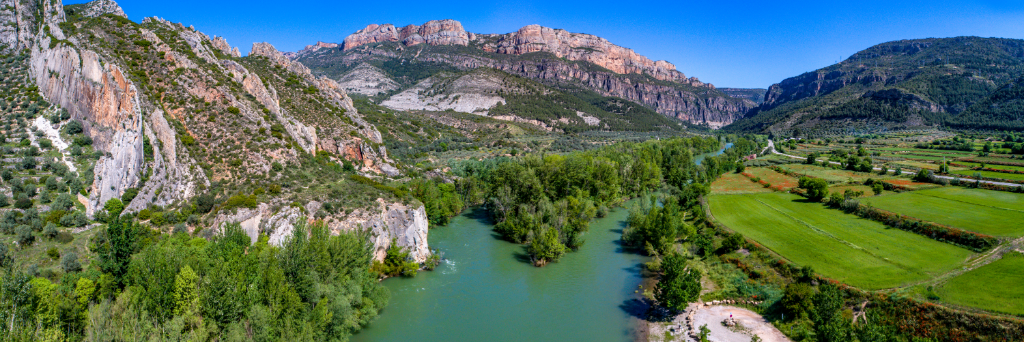It comprises an area that is unified by the Pre-Pyrenean mountain ranges of Montroig and Carbonera, which are calcareous in nature and form impressive cliffs on the Noguera Pallaresa and Segre rivers. It also encompasses the great reservoirs of Camarasa, Sant Llorenç de Montgai and Partidor de Balaguer.
The geological features of this area are characterized by limestone cliffs, which both rivers have eroded, causing excavations in the rock. Harsh folds in the sedimentary strata has defined the fracture zones through which the Segre and Noguera Pallaresa rivers flow.
It is worth highlighting the mountain Sant Salvador in Camarasa, which is also listed as a geozone of interest. The place is formed by a succession of thrust faults that replicate mesozoic series.
In terms of climatic variables, there are significant thermal oscillations between the winter and summer periods, as is typical of the Pre-Pyrenean area of Lleida.
The municipalities shaping the natural space include: Camarasa, Les Avellanes i Santa Linya, Alòs de Balaguer, Foradada, Artesa de Segre, Cubells, Ponts, Os de Balaguer, La Baronia de Rialb, Balaguer and Tiurana.
FLORA AND VEGETATION
The area is composed of a Mediterranean landscape, that is also somewhat continental, indicated by the dominance of the holm oak (Quercetum rotundifoliae). The holm oak occupies a large part of the area, although rupiculous communities on the cliffs and rocky walls are also a significant feature.
The flooded environments bordering the riverbed are occupied by the marshland vegetation of hygrophytes and helophytes, which have a relevant role.
Other communities are also found in this space, such as the false brome thickets (Thero-Brachypodion) or the humid grasslands of Molinio-Holoschoenio.
Among the unique flowers of the area, it is worth highlighting the presence of Petrocoptis montsicciana: a rupiculous species endemic to the Pre-Pyrenees and catalogued as being of community interest.
Flora species from Annex II of Directive 92/43, of habitats
A list referring to the grouping of areas forming part of the Natura 2000 network (Segre- Noguera Pallaresa Confluence)
In the case of the Segre-Noguera Pallaresa confluence ENP (Natural Space of Ponent), the species include: Petrocoptis montsiccian.
WILDLIFE
It is worth mentioning the remarkable representativeness and diversity to be found amongst some of the fauna inhabiting the area. As the Space has a wide variety of habitats and is quite isolated geographically some relevant species of avifauna can happily reside there.
For example, on the series of cliffs overlooking the Camarasa reservoir and on the Sant Antoni ravine there is a griffon vulture (Gyps fulvus) colony. The populations of birds of prey in this territory are very significant, since, apart from griffon vultures, there are also Egyptian vultures (Nephron percnopterus), bearded vultures (Gypaetus barbatus) and peregrine falcons (Falco peregrinus).
The fluvial nature of the space means that it attracts water birds. In the vicinity of the Sant Llorenç de Montgai reservoir, up to 113 different species have been detected, some 52 (46.01%) of which live in the biotopes directly related to the reservoir.
The reservoirs in this area make an ideal refuge for wintering birds, as well as for numerous nesting species. One example of one of these species is the great reed warbler (Acrocephalus arundinaceus), which breeds in reed beds, especially at the end of the Sant Llorenç de Montgai reservoir. Very interesting species are to be found here which are localized to Catalonia, such as the the great crested grebe (Podiceps cristatus), the purple heron (Ardea purpurea) or the black tern (Chlidonias niger).
The otter (Lutra lutra) can also be seen on the riverbanks of this space. The caves in the area are home to numerous colonies of bats, such as the cave bat (Miniopterus schreibersi). Also within the Chiroptera group it is worth highlighting other species including the Mediterranean horseshoe bat (Rhinolophus euryale), the lesser mouse-eared bat (Myotis blythii) or the long-fingered bat (Myotis capaccinii); this last species is commonly found in aquatic environments with still waters, where it hunts insects on the water surface.
From among the fish species we must mention the twait shad (Alosa fallax) as it is one of the most interesting species in the area.
In terms of invertebrates, it is worth noting the presence of some interesting endemisms of arachnids that inhabit the caves.
In the river environments, the Margaritifera auricularia is present: a species of Bivalvia that is both interesting and under threat.
Wildlife species in Annex II of Directive 92/43, on habitats
List referring to the entire Space of the network Natura 2000 of the Segre - Noguera Pallaresa Confluence.
In the case of the Segre-Noguera Pallaresa confluence ENP (Natural Space of Ponent), the species include: Barbastella barbastellus, Cerambyx cerdo, Chondrostoma miegii, Lucanus cervus, Lutra lutra, Miniopterus schreibersi, Myotis blythii, Myotis capaccinii, Myotis emarginatus, Myotis myotis, Rhinolophus euryale, Rhinolophus ferrum-equinum, Rhinolophus hipposi.
Wildlife species in Annex I of Directive 2009/147, on birds
List referring to the entire Space of the network Natura 2000 of the Segre - Noguera Pallaresa Confluence.
In the case of the Segre-Noguera Pallaresa confluence ENP (Natural Space of Ponent), the species include:
Nycticorax nycticorax, Ardea purpurea, Ciconia ciconia, Milvus migrans, Neophron percnopterus, Gyps fulvus, Circaetus gallicus, Circus aeruginosus , Aquila chrysaetos, Hieraaetus pennatus, Hieraaetus fasciatus, Falco peregrinus, Burhinus oedicnemus, Bubo bubo, Caprimulgus europaeus, Alcedo atthis, Calandrella brachydactyla, Galerida theklae, Lullula arborea, Anthus campestris, Oenanthe leucura, Sylvia undata, Pyrrhocorax pyrrhocorax, Emberiza hortulana
